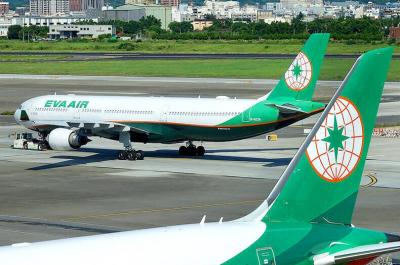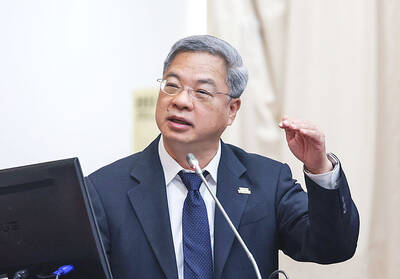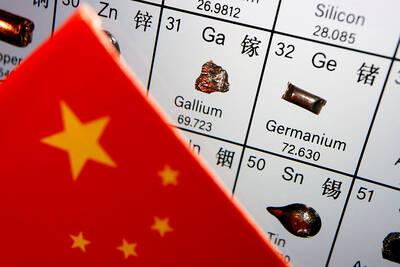National Taiwan University Hospital (NTUH) researchers have found a marker that could help identify people with chronic hepatitis B who are at high risk of developing liver cancer.
People with chronic hepatitis B who are in the “immune-tolerant phase” or the “inactive carrier phase” are usually not advised to take medication for treatment, as they are considered to be at low risk of developing liver cancer, NTUH attending internal medicine doctor Tseng Tai-chung (曾岱宗) told a news conference in Taipei yesterday.
However, the new indicator found using hepatitis B surface antigen quantification could more precisely determine whether these people need further treatment, Tseng said.

Photo: CNA
Hepatitis B infection is a major risk factor for liver cancer, which is the fourth-most common cancer in Taiwan, in terms of case numbers, and caused the second-highest number of cancer deaths last year.
Tseng’s team analyzed long-term follow-up data from cohort studies led by NTUH vice superintendent Kao Jia-horng (高嘉宏) and Academia Sinica academician and former vice president Chen Chien-jen (陳建仁), who is a distinguished professor in the Genomics Research Center, Academia Sinica.
Among the 6,139 people with chronic hepatitis B included in the studies, with follow-up periods of up to 20 or more years, 547 developed liver cancer.
In the first study, Tseng said his team found that non-cirrhotic inactive chronic hepatitis B carriers with serum hepatitis B surface antigen (HBsAg) levels below 100 international units per milliliter (IU/mL) had an annual liver cancer incidence of only 0.08 percent — below the internationally recommended 0.2 percent surveillance threshold.
As these people were near the benchmark, their risk of developing liver cancer was comparable to those without the disease, and therefore could be put on a more relaxed treatment follow-up schedule, he said.
However, for those with HBsAg above 100IU/mL, they could consider seeking new antiviral treatments for suppressing the antigen and reducing the risk of liver cancer, and then continue receiving routine follow-ups, he said.
The findings are significant for precision medicine and optimizing of liver cancer surveillance strategies, NTUH said.
Among inactive chronic hepatitis B carriers, about one-third had low HBsAg levels, so in areas where resources are limited, the other two-thirds with higher levels should be considered for more frequent examinations, Tseng said.
The second study found that those with chronic hepatitis B in the immune-tolerant phase with HBsAg greater than 10,000IU/mL were associated with delayed development of liver cancer, indicating that the antigen could be used as a biomarker to identify those who are truly in the low-risk, immune-tolerant phase and avoid unnecessary treatment, Tseng said.
The results were validated in a large Japanese cohort study, underscoring the diverse clinical value of surface antigen across different disease stages, NTUH said.
The results not only help redefine if someone is partially cured of hepatitis B virus and the clinical management of those in the immune-tolerant phase, but also provide strong evidence for future international treatment guidelines, it said.
The first study was published in the June edition of Gut, an international medical journal on gastroenterology and hepatology, while the second study was published in March in the medical journal Hepatology.

The first global hotel Keys Selection by the Michelin Guide includes four hotels in Taiwan, Michelin announced yesterday. All four received the “Michelin One Key,” indicating guests are to experience a “very special stay” at any of the locations as the establishments are “a true gem with personality. Service always goes the extra mile, and the hotel provides much more than others in its price range.” Of the four hotels, three are located in Taipei and one in Taichung. In Taipei, the One Key accolades were awarded to the Capella Taipei, Kimpton Da An Taipei and Mandarin Oriental Taipei. Capella Taipei was described by

EVA Airways today confirmed the death of a flight attendant on Saturday upon their return to Taiwan and said an internal investigation has been launched, as criticism mounted over a social media post accusing the airline of failing to offer sufficient employee protections. According to the post, the flight attendant complained of feeling sick on board a flight, but was unable to take sick leave or access medical care. The crew member allegedly did not receive assistance from the chief purser, who failed to heed their requests for medical attention or call an ambulance once the flight landed, the post said. As sick

Minister of Economic Affairs Kung Ming-hsin (龔明鑫) yesterday said that private-sector refiners are willing to stop buying Russian naphtha should the EU ask them to, after a group of non-governmental organizations, including the Centre for Research on Energy and Clean Air (CREA), criticized the nation’s continued business with the country. While Taiwan joined the US and its Western allies in putting broad sanctions on Russia after it invaded Ukraine in 2022, it did not explicitly ban imports of naphtha, a major hard-currency earner for Russia. While state-owned firms stopped importing Russian oil in 2023, there is no restriction on private companies to

INDUSTRY: Beijing’s latest export measures go beyond targeting the US and would likely affect any country that uses Chinese rare earths or related tech, an academic said Taiwanese industries could face significant disruption from China’s newly tightened export controls on rare earth elements, as much of Taiwan’s supply indirectly depends on Chinese materials processed in Japan, a local expert said yesterday. Kristy Hsu (徐遵慈), director of the Taiwan ASEAN Studies Center at the Chung-Hua Institution for Economic Research, said that China’s latest export measures go far beyond targeting the US and would likely affect any country that uses Chinese rare earths or related technologies. With Japan and Southeast Asian countries among those expected to be hit, Taiwan could feel the impact through its reliance on Japanese-made semi-finished products and